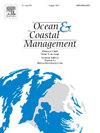A novel risk analysis approach for the liquefication of nickel ore cargo using fault tree analysis integrated failure mode and effect analysis
IF 4.8
2区 环境科学与生态学
Q1 OCEANOGRAPHY
引用次数: 0
Abstract
Liquefaction is the phenomenon in which a material with soil-like properties rapidly transitions from a solid, dry state to a nearly fluid state, posing significant risks to maritime safety. This study employs Fuzzy Fault Tree Analysis (FFTA) and Failure Mode and Effect Analysis (FMEA) to systematically evaluate the risks associated with nickel ore liquefaction. The data were derived from expert consultations, literature review, and theoretical modeling to ensure a robust assessment framework. The analysis revealed that the probability of nickel ore liquefaction is 0.1192, with human-related factors contributing to approximately 54% of all risks. Additionally, the integration of severity and detectability values identified ‘leaking from hatch cover rubbers' as the most critical failure mode, emphasizing the need for enhanced monitoring and crew training. This study uniquely integrates FFTA and FMEA to address human-factor-driven risks in maritime transportation. Unlike existing approaches, this dual-framework method prioritizes failure modes based on both probabilistic and consequence-based analyses, offering actionable insights for improving maritime safety. Compared to traditional methods, the proposed framework provides a comprehensive risk prioritization by integrating probabilistic analysis with consequence evaluation, allowing for more precise risk mitigation strategies.
结合故障模式和影响分析,提出了一种新的镍矿货物液化风险分析方法
液化是一种具有类似土壤性质的物质从固体、干燥状态迅速转变为接近流体状态的现象,对海上安全构成重大风险。本研究采用模糊故障树分析法(FFTA)和失效模式与影响分析法(FMEA)对镍矿液化相关风险进行系统评价。数据来源于专家咨询、文献综述和理论建模,以确保可靠的评估框架。分析表明,镍矿液化的概率为0.1192,其中人为因素约占所有风险的54%。此外,严重性和可探测性值的整合确定了“舱口盖橡胶泄漏”是最关键的故障模式,强调了加强监测和船员培训的必要性。本研究独特地将FFTA和FMEA结合起来,以解决海上运输中人为因素驱动的风险。与现有方法不同,这种双框架方法基于概率和基于结果的分析对故障模式进行优先排序,为提高海上安全提供了可操作的见解。与传统方法相比,拟议的框架通过将概率分析与后果评估相结合,提供了全面的风险优先排序,从而允许更精确的风险缓解策略。
本文章由计算机程序翻译,如有差异,请以英文原文为准。
求助全文
约1分钟内获得全文
求助全文
来源期刊

Ocean & Coastal Management
环境科学-海洋学
CiteScore
8.50
自引率
15.20%
发文量
321
审稿时长
60 days
期刊介绍:
Ocean & Coastal Management is the leading international journal dedicated to the study of all aspects of ocean and coastal management from the global to local levels.
We publish rigorously peer-reviewed manuscripts from all disciplines, and inter-/trans-disciplinary and co-designed research, but all submissions must make clear the relevance to management and/or governance issues relevant to the sustainable development and conservation of oceans and coasts.
Comparative studies (from sub-national to trans-national cases, and other management / policy arenas) are encouraged, as are studies that critically assess current management practices and governance approaches. Submissions involving robust analysis, development of theory, and improvement of management practice are especially welcome.
 求助内容:
求助内容: 应助结果提醒方式:
应助结果提醒方式:


